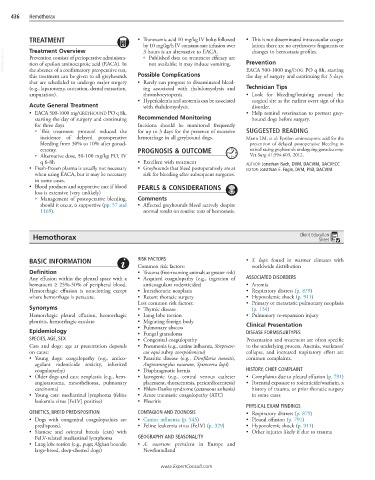Page 898 - Cote clinical veterinary advisor dogs and cats 4th
P. 898
436 Hemothorax
TREATMENT • Tranexamic acid 10 mg/kg IV bolus followed • This is not disseminated intravascular coagu-
by 10 mg/kg/h IV constant-rate infusion over lation; there are no erythrocyte fragments or
Treatment Overview
VetBooks.ir Prevention consists of perioperative administra- ○ Published data on treatment efficacy are Prevention
changes in hemostasis profiles.
3 hours is an alternative to EACA.
not available; it may induce vomiting.
tion of epsilon aminocaproic acid (EACA). In
the absence of a confirmatory preoperative test,
this treatment can be given to all greyhounds Possible Complications EACA 500-1000 mg/DOG PO q 8h, starting
the day of surgery and continuing for 3 days
that are scheduled to undergo major surgery • Rarely can progress to disseminated bleed-
(e.g., laparotomy, castration, dental extraction, ing associated with rhabdomyolysis and Technician Tips
amputation). thrombocytopenia • Look for bleeding/bruising around the
• Hyperkalemia and azotemia can be associated surgical site as the earliest overt sign of this
Acute General Treatment with rhabdomyolysis. disorder.
• EACA 500-1000 mg/GREYHOUND PO q 8h, • Help remind veterinarian to pretreat grey-
starting the day of surgery and continuing Recommended Monitoring hound dogs before surgery.
for three days Incisions should be monitored frequently
○ This treatment protocol reduced the for up to 3 days for the presence of excessive SUGGESTED READING
incidence of delayed postoperative hemorrhage in all greyhound dogs. Marin LM, et al: Epsilon aminocaproic acid for the
bleeding from 30% to 10% after gonad- prevention of delayed postoperative bleeding in
ectomy. PROGNOSIS & OUTCOME retired racing greyhounds undergoing gonadectomy.
○ Alternative dose, 50-100 mg/kg PO, IV Vet Surg 41:594-603, 2012.
q 6-8h • Excellent with treatment AUTHOR: Jonathan Bach, DVM, DACVIM, DACVECC
• Fresh-frozen plasma is usually not necessary • Greyhounds that bleed postoperatively are at EDITOR: Jonathan E. Fogle, DVM, PhD, DACVIM
when using EACA, but it may be necessary risk for bleeding after subsequent surgeries.
in some cases.
• Blood products and supportive care if blood PEARLS & CONSIDERATIONS
loss is extensive (very unlikely)
○ Management of postoperative bleeding, Comments
should it occur, is supportive (pp. 57 and • Affected greyhounds bleed actively despite
1169). normal results on routine tests of hemostasis.
Hemothorax Client Education
Sheet
BASIC INFORMATION RISK FACTORS • S. lupi: found in warmer climates with
Common risk factors: worldwide distribution
Definition • Trauma (free-roaming animals at greater risk)
Any effusion within the pleural space with a • Acquired coagulopathy (e.g., ingestion of ASSOCIATED DISORDERS
hematocrit ≥ 25%-50% of peripheral blood. anticoagulant rodenticides) • Anemia
Hemorrhagic effusion is nonclotting except • Intrathoracic neoplasia • Respiratory distress (p. 879)
where hemorrhage is peracute. • Recent thoracic surgery • Hypovolemic shock (p. 911)
Less common risk factors: • Primary or metastatic pulmonary neoplasia
Synonyms • Thymic disease (p. 134)
Hemorrhagic pleural effusion, hemorrhagic • Lung lobe torsion • Pulmonary re-expansion injury
pleuritis, hemorrhagic exudate • Migrating foreign body Clinical Presentation
• Pulmonary abscess
Epidemiology • Fungal granuloma DISEASE FORMS/SUBTYPES
SPECIES, AGE, SEX • Congenital coagulopathy Presentation and treatment are often specific
Cats and dogs: age at presentation depends • Pneumonia (e.g., canine influenza, Streptococ- to the underlying process. Anemia, weakness/
on cause: cus equi subsp zooepidemicus) collapse, and increased respiratory effort are
• Young dogs: coagulopathy (e.g., antico- • Parasitic disease (e.g., Dirofilaria immitis, common complaints.
agulant rodenticide toxicity, inherited Angiostrongylus vasorum, Spirocerca lupi)
coagulopathy) • Diaphragmatic hernia HISTORY, CHIEF COMPLAINT
• Older dogs and cats: neoplastic (e.g., hem- • Iatrogenic (e.g., central venous catheter • Complaints due to pleural effusion (p. 791)
angiosarcoma, mesothelioma, pulmonary placement, thoracentesis, pericardiocentesis) • Potential exposure to rodenticide/warfarin, a
carcinoma) • Ehlers-Danlos syndrome (cutaneous asthenia) history of trauma, or prior thoracic surgery
• Young cats: mediastinal lymphoma (feline • Acute traumatic coagulopathy (ATC) in some cases
leukemia virus [FeLV] positive) • Pleuritis
PHYSICAL EXAM FINDINGS
GENETICS, BREED PREDISPOSITION CONTAGION AND ZOONOSIS • Respiratory distress (p. 879)
• Dogs with congenital coagulopathies are • Canine influenza (p. 545) • Pleural effusion (p. 791)
predisposed. • Feline leukemia virus (FeLV) (p. 329) • Hypovolemic shock (p. 911)
• Siamese and oriental breeds (cats) with • Other injuries likely if due to trauma
FeLV-related mediastinal lymphoma GEOGRAPHY AND SEASONALITY
• Lung lobe torsion (e.g., pugs; Afghan hounds; • A. vasorum: prevalent in Europe and
large-breed, deep-chested dogs) Newfoundland
www.ExpertConsult.com

